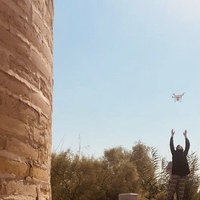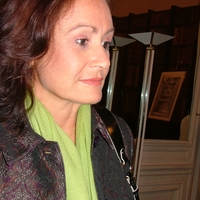
Laura Ebanista
Ricercatore TDA per il SSD L-ANT/09 (Topografia Antica)
Address: Dipartimento di Scienze dell'Antichità - Sapienza Università di Roma, Piazzale A. Moro 5, 00185 Roma
Address: Dipartimento di Scienze dell'Antichità - Sapienza Università di Roma, Piazzale A. Moro 5, 00185 Roma
less
Related Authors
Diego Ronchi
Consiglio Nazionale delle Ricerche (CNR)
Lorenzo Ceruleo
University of Tuscia (Università degli Studi della Tuscia, Viterbo)
Domenico Palombi
Università degli Studi "La Sapienza" di Roma
fabiola gnoli
The University of RomaTre
Alessandro Di Meo
University of Tuscia (Università degli Studi della Tuscia, Viterbo)
Alessandro Maria Jaia
Università degli Studi "La Sapienza" di Roma
Cristina Corsi
University of Cassino and Southern Latium
Maria Grazia Turco
Università degli Studi "La Sapienza" di Roma
InterestsView All (6)








Uploads
Books by Laura Ebanista
Papers by Laura Ebanista
images and the extraction of all the possible vegetation indexes on the basis of the spectral bands of the specific camera used (Sentera 6X). The tests, carried out in different contexts (Antium, Nersae), analyze the readability of the index data extracted from multispectral images in comparison with the marks visible in the panchromatic images, especially considering cases in which the marks are visible only in processed indices that interpolate the NIR band.
Furthermore, the particular conformation of the Ninfa area presumably results from a sinkhole phenomenon, an element of geological risk widespread throughout the Pontine area.
This paper traces the history of the population of the Ninfa district from the ancient age, in the light of the complex settlement dynamics of the Pontine plain, an area characterized by the presence of marshes, more or less extensive depending on the historical period. Several regimentation works were undertaken over the centuries.
The population development is considered in the light of the complex hydrogeological situation of the Ninfa village, generated by a sinking phenomenon (sinkhole), characteristic of this area.
a multispectral camera transported by a UAV and their reading and interpretation in the context of the archaeological diagnostics.
As part of the activities, the integration of a Sentera 6X sensor on board a DJI Phantom 4 drone was tested, both from a mechanical and software data management point of view, from the programming, to the acquisition, up to the final processing and extraction of vegetation indices.
The SAPR is highly performing as well as very agile use in the specific contexts of research and has returned satisfactory results in the data extraction and processing phase.
https://www.geomediaonline.it/report1/396-integrazione-di-un-sensore-sentera-6x-a-bordo-di-un-drone-phantom-4-una-sperimentazione-in-campo-archeologico
numerosi studi, anche piuttosto recenti, l’attribuzione della posizione del faro è stato codificata con le fondazioni della omonima
torre medievale da Fabio Piccarreta negli anni ‘70 dello scorso secolo e mai ripresa in maniera analitica. L’analisi diretta delle
strutture e lo studio della topografia dell’impianto portuale presentati in questa sede, consentono di rivalutare la questione e di
proporre un modello differente caratterizzato da almeno due fasi edilizie.
This contribution addresses the topic of the location of the Astura lighthouse. If the topographical analysis of the harbour has
been already considered in several studies, even quite recently, the location of the lighthouse has been codified by Fabio Piccarreta
in 70’s of the last century. The building has been attributed to the foundation of the medieval tower of Astura and the question was
never resumed analytically. The direct analysis of the structures combined with the analysis of the topography of the harbour leads
to re-evaluate the issue and propose a different model characterized by at least two building phases.
by humans to represent the world in which they lived, including the difficulties faced in representing the spherical
earth (Anaximander), until the well-known Tabula Peutingeriana, a map which documents the oikoumene. In
1928 Crawford highlighted the importance of a European historical map, choosing the International Map of the
World (IMW) as the cartographic base for the Tabula Imperii Romani, subdividing this into sheets at a scale of
1:1,000,000.
In more recent times, the TIR has tackled the transition from a printed to a digital format and the last part
of this paper deals with the complex mechanism of transposing the data from printed maps to the most modern
GIS and WebGIS systems. This issue reveals numerous critical topics, including accurate positioning and the
problem of varying scale ratios.
lacustre e dunale. In questo contesto, sono presi in esame i tre corsi d’acqua che corrono ortogonali alla costa (Astura, Moscarello e Rio Martino) rispetto alla loro funzione nelle dinamiche di sviluppo della piana in relazione alle operazioni di regimentazione intraprese nel corso dei secoli fino alla Bonifica Integrale degli anni ’30 dello scorso
secolo.
Thanks to the collaboration of the family, in this paper two unpublished fragments of black-glazed pottery
with painted inscriptions are examined. Considering the archaeological data of the presumed context, the
vascular typology and the epigraphic data, the two inscriptions have been attributed to Libero and Libera
and to the Tempestates and dated to the Middle Republican Age.
in Lavinium in the 80’s of the last century. The interest of the find is the uncommon decorative system,
when compared to other PSC skyphos from Italy, with the presence of three bands along the external rim.
images and the extraction of all the possible vegetation indexes on the basis of the spectral bands of the specific camera used (Sentera 6X). The tests, carried out in different contexts (Antium, Nersae), analyze the readability of the index data extracted from multispectral images in comparison with the marks visible in the panchromatic images, especially considering cases in which the marks are visible only in processed indices that interpolate the NIR band.
Furthermore, the particular conformation of the Ninfa area presumably results from a sinkhole phenomenon, an element of geological risk widespread throughout the Pontine area.
This paper traces the history of the population of the Ninfa district from the ancient age, in the light of the complex settlement dynamics of the Pontine plain, an area characterized by the presence of marshes, more or less extensive depending on the historical period. Several regimentation works were undertaken over the centuries.
The population development is considered in the light of the complex hydrogeological situation of the Ninfa village, generated by a sinking phenomenon (sinkhole), characteristic of this area.
a multispectral camera transported by a UAV and their reading and interpretation in the context of the archaeological diagnostics.
As part of the activities, the integration of a Sentera 6X sensor on board a DJI Phantom 4 drone was tested, both from a mechanical and software data management point of view, from the programming, to the acquisition, up to the final processing and extraction of vegetation indices.
The SAPR is highly performing as well as very agile use in the specific contexts of research and has returned satisfactory results in the data extraction and processing phase.
https://www.geomediaonline.it/report1/396-integrazione-di-un-sensore-sentera-6x-a-bordo-di-un-drone-phantom-4-una-sperimentazione-in-campo-archeologico
numerosi studi, anche piuttosto recenti, l’attribuzione della posizione del faro è stato codificata con le fondazioni della omonima
torre medievale da Fabio Piccarreta negli anni ‘70 dello scorso secolo e mai ripresa in maniera analitica. L’analisi diretta delle
strutture e lo studio della topografia dell’impianto portuale presentati in questa sede, consentono di rivalutare la questione e di
proporre un modello differente caratterizzato da almeno due fasi edilizie.
This contribution addresses the topic of the location of the Astura lighthouse. If the topographical analysis of the harbour has
been already considered in several studies, even quite recently, the location of the lighthouse has been codified by Fabio Piccarreta
in 70’s of the last century. The building has been attributed to the foundation of the medieval tower of Astura and the question was
never resumed analytically. The direct analysis of the structures combined with the analysis of the topography of the harbour leads
to re-evaluate the issue and propose a different model characterized by at least two building phases.
by humans to represent the world in which they lived, including the difficulties faced in representing the spherical
earth (Anaximander), until the well-known Tabula Peutingeriana, a map which documents the oikoumene. In
1928 Crawford highlighted the importance of a European historical map, choosing the International Map of the
World (IMW) as the cartographic base for the Tabula Imperii Romani, subdividing this into sheets at a scale of
1:1,000,000.
In more recent times, the TIR has tackled the transition from a printed to a digital format and the last part
of this paper deals with the complex mechanism of transposing the data from printed maps to the most modern
GIS and WebGIS systems. This issue reveals numerous critical topics, including accurate positioning and the
problem of varying scale ratios.
lacustre e dunale. In questo contesto, sono presi in esame i tre corsi d’acqua che corrono ortogonali alla costa (Astura, Moscarello e Rio Martino) rispetto alla loro funzione nelle dinamiche di sviluppo della piana in relazione alle operazioni di regimentazione intraprese nel corso dei secoli fino alla Bonifica Integrale degli anni ’30 dello scorso
secolo.
Thanks to the collaboration of the family, in this paper two unpublished fragments of black-glazed pottery
with painted inscriptions are examined. Considering the archaeological data of the presumed context, the
vascular typology and the epigraphic data, the two inscriptions have been attributed to Libero and Libera
and to the Tempestates and dated to the Middle Republican Age.
in Lavinium in the 80’s of the last century. The interest of the find is the uncommon decorative system,
when compared to other PSC skyphos from Italy, with the presence of three bands along the external rim.
Consorzio di Bonifica concerning archaeological finds during the reclamation
of the Thirties of last century, mostly of the letters where exchanged
between the Consorzio and the Office of Archaeological Heritage responsible
for the territory. Through the study of the documents was possible
to retrieve unknown information and to connect archaeological finds
and topographic contexts.
the site of the mosque. The results of the excavation, compared with Herzfeld’s archaeological tests
dating to 1932, provided new insights into the arrangement of the buildings in the area and, more
generally, the planning of this sector of the city during the early Islamic period.